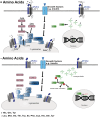The human LAT1-4F2hc (SLC7A5-SLC3A2) transporter complex: Physiological and pathophysiological implications
- PMID: 36460306
- PMCID: PMC11497297
- DOI: 10.1111/bcpt.13821
The human LAT1-4F2hc (SLC7A5-SLC3A2) transporter complex: Physiological and pathophysiological implications
Abstract
LAT1 and 4F2hc form a heterodimeric membrane protein complex, which functions as one of the best characterized amino acid transporters. Since LAT1-4F2hc is required for the efficient uptake of essential amino acids and hormones, it promotes cellular growth, in part, by stimulating mTORC1 (mechanistic target of rapamycin complex 1) signalling and by repressing the integrated stress response (ISR). Gain or loss of LAT1-4F2hc function is associated with cancer, diabetes, and immunological and neurological diseases. Hence, LAT1-4F2hc represents an attractive drug target for disease treatment. Specific targeting of LAT1-4F2hc will be facilitated by the increasingly detailed understanding of its molecular architecture, which provides important concepts for its function and regulation. Here, we summarize (i) structural insights that help to explain how LAT1 and 4F2hc assemble to transport amino acids across membranes, (ii) the role of LAT1-4F2hc in key metabolic signalling pathways, and (iii) how derailing these processes could contribute to diseases.
Keywords: 4F2hc; LAT1; disease; integrated stress response; mTORC1.
© 2022 The Authors. Basic & Clinical Pharmacology & Toxicology published by John Wiley & Sons Ltd on behalf of Nordic Association for the Publication of BCPT (former Nordic Pharmacological Society).
Conflict of interest statement
The authors declare there are no conflict of interest.
Figures


References
Publication types
MeSH terms
Substances
Grants and funding
LinkOut - more resources
Full Text Sources
Research Materials

